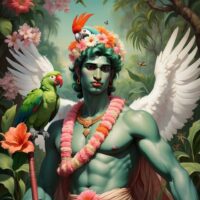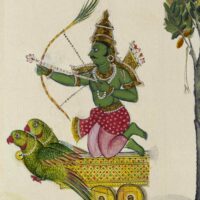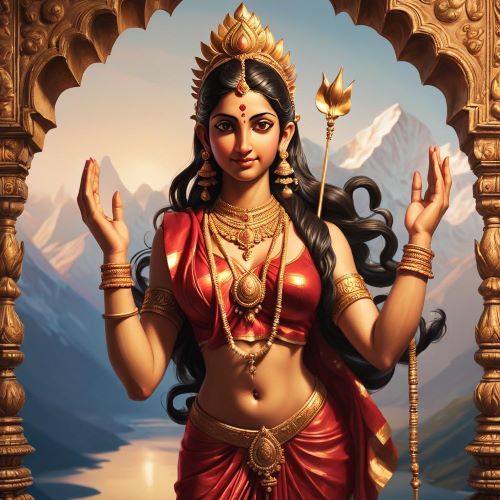Kamadeva : God of Love
Listen
At a glance
| Description | |
|---|---|
| Origin | Indian Mythology |
| Classification | Gods |
| Family Members | Vishnu (Father), Sri (Mother) |
| Region | India |
| Associated With | Love, Lust, Desire |
Kamadeva
Introduction
Kamadeva, the Indian god of love in Hindu mythology, epitomizes desire and attraction. Revered for sparking romantic passion and devotion, his legend spans ancient texts and cultural interpretations. In Hindu mythology, Kamadeva reigns supreme as the embodiment of love and passion, wielding a profound influence on creation and procreation. Known also as Kama or Manmatha, he holds a significant place alongside his consort, Rati.
Physical Traits
Kamadeva, the Indian god of love, is portrayed as a strikingly handsome young deity whose appearance radiates the irresistible charm of romantic attraction in Hindu mythology. His skin, often depicted in shades of green or reddish hues, symbolizes the rejuvenation of spring and the fervor of desire. Holding a bow crafted from sugarcane, Kamadeva embodies the sweetness and seduction inherent in love. His arrows, uniquely adorned with five distinct flowers, each carry profound symbolic meanings: the White Lotus signifies purity and spiritual love, Ashoka Tree Flowers denote new beginnings and passionate love, Mango Tree Flowers symbolize fertility and desire, Jasmine embodies attachment and deep connection, and the Blue Lotus represents fidelity and unwavering devotion.
Accompanied by his faithful parrot, renowned for its ability to mimic and symbolize communication in matters of love, Kamadeva rides a celestial creature resembling a swan or parrot, enveloped in the essence of spring. Surrounded by gentle breezes and the hum of bees, he epitomizes the harmonious connection between love and the natural world, captivating both mortals and gods with his divine presence. In Hindu iconography, Kamadeva’s depiction as a youthful and adorned deity underscores his role as the embodiment of love’s allure, resonating with the vitality and sensuality that define his mythological significance.
Family
In Hindu mythology, Kamadeva’s parentage is subject to varying accounts. One prevalent narrative identifies him as the son of the powerful creator deity Brahma, while another widely accepted belief attributes his birth to Lord Vishnu, the preserver, and Goddess Lakshmi, the goddess of prosperity and fortune. Some interpretations also link Kamadeva with specific incarnations of these deities, such as Krishna, an avatar of Vishnu, and Rukmini, an incarnation of Lakshmi. Despite these differences in lineage across texts, Kamadeva consistently holds the esteemed position as the god of love.
Kamadeva is often portrayed alongside his consort, Rati, who embodies passion and desire, symbolizing the perfect union of spiritual and physical love. Together, they epitomize the harmonious balance between affection and attraction, which forms the essence of fulfilling relationships in Hindu mythology.
Other names
Kamadeva, revered across diverse texts and regions within India, is known by several names in Hindu mythology, each revealing a unique aspect of his role as the god of love and desire. In Sanskrit, he is often referred to as Madana, which highlights his ability to intoxicate and captivate beings with his arrows of desire. This name underscores his profound influence in stirring emotions and shaping relationships. Additionally, Kamadeva is recognized as Kama, symbolizing basic desire and longing, and Manmatha, emphasizing his role in agitating minds and igniting passionate feelings. His epithets like Kandarpa, Madana, and Smara further illustrate his power to inflame and enchant, portraying him as both a catalyst for love and an embodiment of its intoxicating allure.
Each name assigned to Kamadeva not only enriches his character but also reflects the cultural and mythological significance he holds across different narratives. Whether as Ananga, symbolizing the bodiless aspect linked to a particular mythological tale, or as the enchanting Madana whose arrows are likened to flowers, Kamadeva’s diverse appellations underscore his pivotal role in Hindu cosmology as the deity who shapes the dynamics of love and desire.
Powers and Abilities
Kamadeva’s essence lies in his ability to evoke love and desire through his flower-tipped arrows, which affect even the most stoic individuals, ensuring the continuation of life through procreation. Beyond his arrows, Kamadeva exudes an unmatched charm and magnetism, embodying love’s essence and inspiring affection and connection between individuals. He symbolizes hope and optimism, illustrating the transformative power of love in our lives. With his sugarcane bow and fragrant flower-tipped arrows, Kamadeva kindles passion in gods and mortals alike, influencing spiritual yearning and creative inspiration. His presence in Hindu mythology underscores emotions’ profound impact on human existence and the delicate balance between worldly desires and spiritual growth.
One of Kamadeva’s most intriguing stories involves his encounter with Lord Shiva, the destroyer god. During a period of intense meditation, Shiva sought withdrawal from all worldly affairs, including love. However, the universe required love’s power to maintain balance. Kamadeva intervened to rekindle love between Shiva and his consort, Parvati, despite the potential consequences. Enraged by this disruption, Shiva unleashed his third eye’s cosmic fire, reducing Kamadeva to ashes. Chaos ensued, prompting Rati, his grief-stricken wife, to plead for his return. Recognizing love’s importance, the gods appealed to Shiva. Moved by Parvati’s devotion and understanding love’s necessity for creation, Shiva agreed to resurrect Kamadeva. Unable to return in his physical form due to the intense fire, Kamadeva was reborn as Ananga, a formless spirit who continued wielding love’s power alongside Rati. This tale underscores the delicate balance between passion and restraint, where Kamadeva symbolizes love’s vitality and Shiva embodies discipline and detachment essential for equilibrium in life.
Modern Day Influence
Kamadeva’s enduring legacy thrives in contemporary culture through diverse artistic expressions, literature, and festive traditions. Classical dance forms such as Bharatanatyam and Odissi eloquently depict his romantic allure and divine attributes, preserving his significance in visual storytelling. In popular media, themes of love and desire frequently echo Kamadeva’s timeless relevance, resonating with audiences across generations. Festivals like Holi, known as the festival of colors, invoke Kamadeva’s spirit, symbolizing spring’s arrival and the rejuvenation of life’s vibrant energies. In India, Kamadeva remains a central figure celebrated during Vasant Panchami, honoring the onset of spring—a season synonymous with love and renewal.
Temples dedicated to love and fertility often feature images of Kamadeva, while his story continues to inspire diverse forms of art, literature, and dance throughout the country. Beyond India, Kamadeva’s influence reverberates globally, with parallels found in the roles of the Greek god Eros and the Roman god Cupid, both revered for their associations with love and desire. Across cultures, artistic interpretations of these deities draw inspiration from Kamadeva’s portrayal, highlighting his enduring impact on celebrating love’s multifaceted nature in human experience.
Related Images
Frequently Asked Questions
What is lorem Ipsum?
I am text block. Click edit button to change this text. Lorem ipsum dolor sit amet, consectetur adipiscing elit. Ut elit tellus, luctus nec ullamcorper mattis, pulvinar dapibus leo.
What is lorem Ipsum?
I am text block. Click edit button to change this text. Lorem ipsum dolor sit amet, consectetur adipiscing elit. Ut elit tellus, luctus nec ullamcorper mattis, pulvinar dapibus leo.
What is lorem Ipsum?
I am text block. Click edit button to change this text. Lorem ipsum dolor sit amet, consectetur adipiscing elit. Ut elit tellus, luctus nec ullamcorper mattis, pulvinar dapibus leo.
What is lorem Ipsum?
I am text block. Click edit button to change this text. Lorem ipsum dolor sit amet, consectetur adipiscing elit. Ut elit tellus, luctus nec ullamcorper mattis, pulvinar dapibus leo.
What is lorem Ipsum?
I am text block. Click edit button to change this text. Lorem ipsum dolor sit amet, consectetur adipiscing elit. Ut elit tellus, luctus nec ullamcorper mattis, pulvinar dapibus leo.












